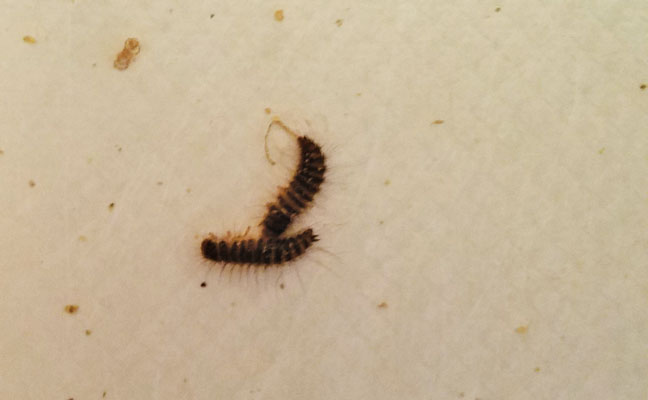
The possible sources of these Dermestid beetle larvae found in a customer’s kitchen cabinets are as diverse as they are numerous. Fortunately, you likely will not need to look far. Photo: Mark Sheperdigian, BCE
Q: Little insects keep showing up in the kitchen cabinets of a home I service. The home is spotless, and the owners just moved in, so there isn’t much food in the home yet. What’s the best thing to do? —MYSTIFIED IN MICHIGAN
A: These are larvae of Dermestid beetles (family Dermestidae). It’s likely they are larder beetles (Dermestes lardarius), judging by the two prominent horns sticking up from the tail end. Other Dermestids include warehouse beetles (Trogoderma spp.) and carpet beetles (Anthrenus spp.). The best thing to do is find and remove the source.
These beetles feed on dried, high-protein substances, both animal and vegetable. You start by looking for stored products left unused, or even forgotten. The possible sources are as diverse as they are numerous. We find Dermestid beetles eating cereals, baking mixes, pastas, pet food, dried meats, fur, feathers and much more. Impressive, no? Entomologists must even protect their dried insect specimens, or Dermestids will ruin the collection.
Start by ensuring there are no obvious sources of stored food or other susceptible goods. It sounds like this already has been done, but they keep showing up. The good news is that the larvae travel slowly and do not go far from the source, so you’re close already.

Like other Dermestids, the larder beetle (Dermestes lardarius) adult does not much resemble its childhood photos. Photo: Mohammed El Damir, Bugwood.org
Is there evidence of mice? This scenario has all the earmarks of a mouse hoard. Both mice and rats typically will stash food for later use — and it’s often more food than they can eat in a lifetime. It is quite common for mice in a home to hoard dog food that has been stored in bulk.
The false bottom of the kitchen cabinets is one of the more common places to discover a mouse hoard. Inspecting false bottoms is not difficult, but may require some tools. There are many reasonably priced borescopes available that have a camera mounted on a flexible rod and will connect to your smartphone. Alternatively, you could drill a hole in an inconspicuous spot and just look in. If you don’t find a mouse hoard there, keep looking. Mice are resourceful and agile, and can hoard their food in wall voids and other structural cavities.
A stored cache of food definitely is the most common source, but Dermestid beetles can infest every aspect of a mouse infestation. They can feed on fur and other items left in mouse nests. They also can feed on droppings, dried rodent carcasses, and even the rodenticide used to kill the mice. In fact, a forgotten box of a popular over-the-counter brand’s meal-based rodenticide is often the source of many stored product pest infestations found in homes.
When Dermestid adults or larvae are showing up in a home, and no obvious source is found among the stored goods, it’s time to think about a mouse hoard.
Email your questions about insect identification and pest management technologies to pmpeditor@northcoastmedia.net. Your questions most likely will be printed and answered in one of Pest Management Professional’s upcoming columns.
You can reach Mark Sheperdigian, BCE, vice president of technical services, Rose Pest Solutions, Troy, Mich., at shep@rosepest.com.
The post Ask the Expert: The link between Dermestids and rodents appeared first on Pest Management Professional.
from Pest Management Professional https://www.mypmp.net/2019/12/04/ask-the-expert-the-link-between-dermestids-and-rodents/
Sacramento CA
No comments:
Post a Comment